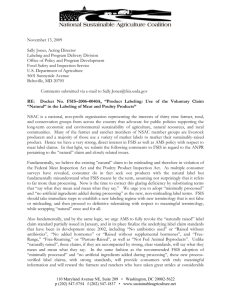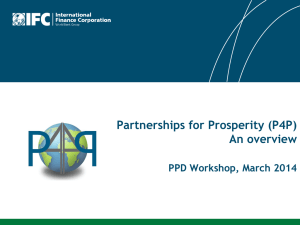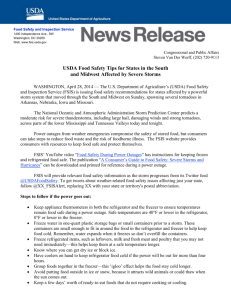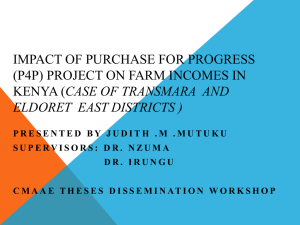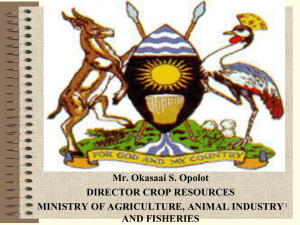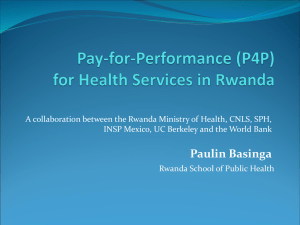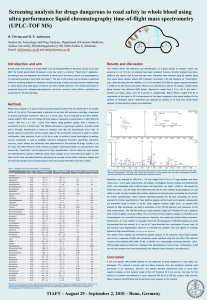Update on National Residue Program
advertisement
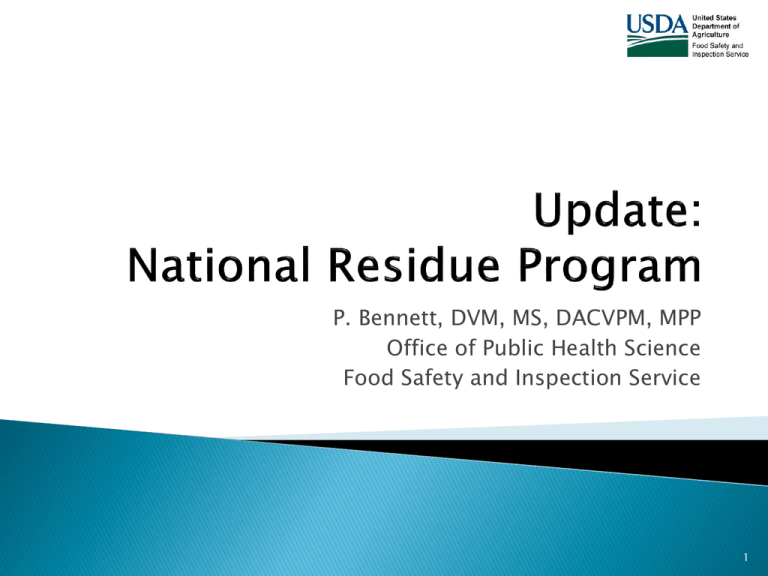
P. Bennett, DVM, MS, DACVPM, MPP Office of Public Health Science Food Safety and Inspection Service 1 Historical Perspectives NRP Initiatives ◦ Restructure NRP ◦ Establish public health safety levels ◦ Establish methods framework Questions 2 To protect consumers from unsafe exposure to chemical residues in meat, poultry, and egg products http://www.culinate.com/hunk/29180 3 1967-8 Wholesome Meat and Poultry Acts 1975-1984 Memorandums of Understanding: Give authority to Surveillance Advisory Team (SAT) & Interagency Residue Control Group (IRCG) 1979 Implementation of Swab Test on Premises (STOP) 1980 First Compound Ranking System 1981 FDA executes first successful prosecution as a result of STOP 4 1995 FSIS Implementation of Fast Antimicrobial Screen Test (FAST) 1996 HACCP Implementation 2009 Begin Kidney Inhibition Swab (KIS) Implementation 2011 Begin using Multi-class method for testing pesticides 2012 Begin using Multi-class method for testing veterinary drugs 5 NRP Goals Monitor chemical exposure in the industry Revise residue sampling & scheduling algorithms Respond to public and stakeholder concern Develop analytical techniques and improve analysis Improve documentation of chemical hazards Identify trends and high-priority compounds to research Establish protocol for recall decisions 6 EPA FDA -Manages farm-to-fork testing and feed analysis -Conducts on-farm investigations -Prevents violations through testing and regulatory action -Enforces the tolerances of animal drugs in meat, poultry, and egg products and prevents improper use of these drugs on farm -Improved coordination and communication between tiers - Share residue data, safety limits, and analytical methods -Provides data for continuous baseline sampling -Uses residue data to adjust or establish tolerances and safety limits -Regulates the use of pesticides through establishment of tolerances in meat, poultry and egg products and prevents improper use of these chemicals 7 MOU: Memorandum of Understanding: • Working relationship between FSIS, AMS, FDA, EPA to coordinate regulatory activities for residues • FSIS consults mainly with FDA/EPA to compare information on regulations IRCG: Interagency Residue Control Group: • FSIS/FDA/EPA/AMS/ CDC/ARS; monthly meetings for updates and collaborating relative to the NRP SAT: Surveillance Advisory Team: • Interagency committee that determines the chemical compounds and production classes of public health concern 8 To minimize risks to consumers from chemical hazards To “catch the next melamine” and detect new hazards To more efficiently collect necessary residue data for risk assessments To develop NRP processes that are easily translated for smooth import and export 9 Restructure NRP Establish methods framework Establish public health safety levels 10 New methods Restructure NRP Tiered approach Hazard ID and ranking 11 New methods Restructure NRP Tiered approach Hazard ID and ranking 12 Modern approach to residue testing Collaboration with Agricultural Research Service FSIS labs received new methods in 2011 The MRM methods be implemented as part of overall improvements to NRP 13 MRM: a Significant Improvement Distinguish individual •Chemical method analytes Screen many types of analytes Screen up to 120+ analytes • NOT JUST ANTIBIOTICS • First time FSIS to use this type of method • First time FSIS method to analyze multiple chemicals per sample 14 Beta-Agonists Beta-Lactams & Cephalosporins Hormones Macrolides & Lincosamides MRM Classes Analgesics & Antiinflammatory Phenicols Fluoroquinolones Sulfas Tetracyclines 15 Fluoroquinolone Desethylene Ciprofloxacin Norfloxacin Ciprofloxacin Danofloxacin Enrofloxacin Sarafloxacin Hormones Prednisone* Oxyphenylbutazone (pork only)* Flunixin Phenylbutazone (pork only) Beta/Dexa-methasone* Tetracycline Macrolide/Lincosamide Lincomycin Pirlimycin Clindamycin Gamithromycin* Tilmicosin Erythromycin Tylosin Analgesic/Antiinflammatory Oxytetracline Tetracyline Chlortetracycline Phenicol Florfenicol Amine (pork only) Florfenicol Chloramphenicol * Indicates analytes not tested/not tested in recent years. 16 Sulfonamide Sulfanilamide (pork only)* Sulfadiazine Sulfathiazole Sulfapyridine Sulfamerazine Sulfamethiazole Sulfamethazine Sulfamethoxypyridazine Sulfachloropyridazine Sulfadoxine Sulfamethoxazole Sulfaethoxypyridazine Sulfadimethoxine Sulfaquinoxaline Sulfanitran* β-Agonist Salbutamol Cimaterol Ractopamine Β-Lactam/ Cephalosporin Cefazolin DCCD Ampicillin Difloxacin Penicillin G Oxacillin Cloxacillin Nafcillin Dicloxacillin * Indicates analytes not tested/not tested in recent years. 17 Screening method ◦ Specific screening ◦ Improved sensitivity ◦ Level assessment Confirmatory method ◦ Multi class method reduces time and need for class-specific confirmation tests 18 Analytes in the Aminoglycosides Method Neomycin Gentamicin Spectinomycin Apramycin Aminoglycosides Analytes Dihydrostreptomycin Hygromycin B Amikacin Streptomycin Kanamycin 19 Benzimidazole Carbamate Conazoles/Triazoles Halogenated Pesticide Classes Imidazoles Organonitrogen Organophosphates Pyrethroids Triazines 20 Benzimidazole Thiabendazole Carbamate Carbaryl Carbofuran Methomyl Organophosphorus Acephate Azinphos-methyl Chlorpyrifos Chlorpyrifos-methyl Dichlorvos (DDVP) Ethofumesate Tetrachlorvinphos Organonitrogen Metalaxyl Tebufenozide Pyrethroids Bifenthrin Cyhalothrin-L Cypermethrin Deltamethrin Permethrin (cis & trans) Tefluthrin Triazines Simazine Conazoles / Triazoles Difenoconazole Myclobutanil Propiconazole Tetraconazole 21 Halogenated Halogenated ◦ ◦ ◦ ◦ ◦ ◦ ◦ ◦ ◦ ◦ ◦ ◦ ◦ ◦ ◦ Alachlor Aldrin Boscalid Carfentrazone-ethyl Chlordane, cisChlordane, transClofentezine Dieldrin Diflubenzuron Diuron Endosulfan I Endosulfan II Endosulfan sulfate Fipronil Heptachlor Heptachlor epoxide (cis & trans) Imidacloprid Linuron Nonachlor, transNorflurazon Oxychlordane Pronamide Propachlor Propanil Pyridaben Thiamethoxam Imidazoles Imazalil Other Compounds Indoxacarb Methoxyfenozide Mirex Piperonyl butoxide 22 Elements in the Metals Method Lead Cadmium Manganese Metals Elements Thallium Selenium Cobalt Molybdenum 23 Florfenicol Florfenicol *** Tylosin *** Neomycin Tilmicosin *** Tetracycline *** Oxytetracycline Desfuroylceftiofur (as DCA or DCCD) *** denotes 7-plate bioassay *** Ampicillin Chloramphenicol *** Chlortetracycline *** Penicillin Arsenic Ivermectin Ivermectin Doramectin Doramectin Moxidectin Moxidectin Cadmium Cadmium Lead Lead Flunixin Flunixin p,p'-DDE Mirex Alpha-BHC Aldrin Carbadox Ractopamine Sulfathiazole (SUL2) Sulfamethazine (SUL2) Sulfadimethoxine (SUL2) Sulfamethoxazole (SUL) Sulfadiazine (SUL) Sulfathiazole (SUL) Sulfamethazine (SUL) Sulfadimethoxine (SUL) Relative % MU (normalized) for quantitative FSIS CLG methods 180 140 100 60 20 24 Methods for the analysis of food composition, food additives, nutrients, veterinary drug and pesticide residues. Methods provide analysts with documentation to facilitate training, performance, quality assessment, and interpretation of data. The contents are continuously revised and updated. http://www.fsis.usda.gov/Science/Chemistry_Lab_Gui debook/index.asp 25 FSIS Method Implementation: Proposed Timetable • MRM method: Targeted sampling 2012 2013 • Aminoglycosides Method: Scheduled and Targeted sampling programs • Metals method: Exploratory program • MRM as a screening method in Eastern and Western labs for Scheduled sampling program 26 New methods Restructure NRP Tiered approach Hazard ID and ranking 27 Scheduled Sampling Program ◦ Headquarters generated ◦ Across production classes Targeted Sampling Program ◦ (Field)Inspector generated ◦ Directed at a particular plant/production class/chemical ◦ Focused 28 Tier 1 – Scheduled Sampling: Appropriate Methods Violative Residues May direct sample for Tier 2 Testing Violative Residues May direct sample for Tier 3 Testing Violative Residues Additional testing Tier 2 – Targeted Sampling: Appropriate Methods Tier 3 – Targeted Flock/Herd: Appropriate Methods 29 New methods Restructure NRP Tiered approach Hazard ID and ranking 30 Define the Universe of Chemical Hazards Screen to Establish a Priority List Risk Based Priority List Select compounds from Priority List Determine appropriate Public Health Safety Level Enter into scheduling algorithm National Residue Program Risk Management 31 Restructure NRP Establish methods framework Establish public health safety levels 32 Developing policies Peer Review FDA Input Methodology to determine PH safety levels 33 Restructure NRP Establish methods framework Establish public health safety levels 34 FDA/FSIS collaboration Develop a process to expedite approval of new testing methodologies for FSIS. Develop a comparison protocol to facilitate using new analytical methods while retaining the linkage to the safety package prepared to support the new animal drug approval 35 The NRP initiatives will result in: Identify emerging contaminants Prevent adulterated meat, poultry, and egg products from entering the marketplace http://www.quicklabel.com/blog/wp-content/uploads/2011/07/iStock_000011997708Small.jpg Discourage improper behavior by producers, processors, and importers Close regulatory gaps between Agencies http://media.treehugger.com/assets/images/2011/10/cute-kid-eating-meat-steakphoto.jpg 36 Terry Dutko Vivian Chen Patricia Nedialkova David Goldman Lynn Cruikshank Allie Miraglia Lou Bluhm Margaret O’Keefe Emilio Esteban Naser Abdelmajid Sarah Edwards David LaBarre Janell Kause Alex Domesle Alice Thaler Jade Mitchell-Blackwood Pat Basu Kerry Dearfield 37 Patty Bennett Patty.Bennett@FSIS.USDA.gov 202-690-6189 38

